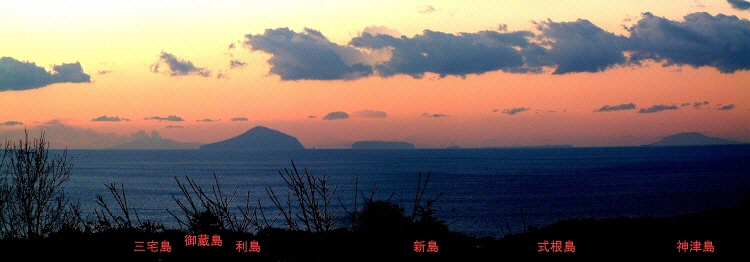 |
 |
 |
|
 |
 |
 |
|
 |
 |
 |
 |
 |
 |
|
 |
 |
 |
|
 |
 |
 |


| In December, 2000,
our "Alaiso" weekend house was completed at Izu Kogen near the rugged seashore
("Alaiso"), 100km south-west of Tokyo downtown. In the weekends,
we stay either in Alaiso House or in Ayame Cottage in Mt. Yatsugatake.
From the roof of Alaiso House, 150 degrees of sea horizon and 40 degrees
of Amagi mountains can be viewed. On the horizon can be seen Boso
Peninsula, Oshima Island and other Izu Islands as the picture above shows.
Izu Peninsula is unique in Japan. It is the only landmass of Japan on the Philippine Plate. It came floated from south and bumped at Honshu, the main island of Japan, to create volcanos. Only 100 km offshore to the east, the expanding Pacific Plate is sinking below the Philippine Plate. Along the boundary on the Philippine Plate side, therefore, volcanos created a north-south array of islands called Izu Islands. Alaiso House is located in Izu Kogen in the middle of the east coast of Izu Peninsula. Izu Kogen is a villa town developed since the railroad Izu Express was completed near there in 1961. It is far enough from Tokyo for quite different environment to change the moods, but near enough to get there in a 2.5 hour drive from our home in Hachioji, Tokyo. Most seashores of Izu Peninsula and Izu Islands consist of rugged lava rock cliffs, created by struggle between the land and the sea. Many areas of Izu Peninsula is covered with fractured lava, on which trees grow thick. On one of such heights of lava stands our Alaiso House, at the altitude of only 115 meters above the sea level. The landscape is, therefore, somewhat similar to that in the 17 mile drive in Montrey. Like in Montrey, pheasants call and squirrels jump around branches. The six-hour trekking trail along the Jogasaki seashore is good for nature study and the rugged seashore scenary. It reminds Shig of a seaside park in Yamaguchi Prefecture where he was brought up to the highschool days. Natural hot spring is an ample resource of Izu. The hot spring water, rich in Na, Ca, Cl, SO4 and CO3, is piped into the villa town and every house is compulsorily, with pleasure, fed with it for bathing. Warm weather due to the lower latitude and the sea water is another feature. Sue appreciates it very much because she doesn't like chill and because she can see flowers earlier. Some cherries bloom even in early February. Fish caught near-by is fresh and delicious, and water filtered through mineral-rich volcanic ash is super. There are "inumerable" number of relatively small scale museums, maybe 20 or so, in Izu Kogen, enhancing the cultural image of the area. It's fun to visit them one after another. Shig grew up in a seaside town and Sue was brought up in a mountain country with aspiration for the sea. For both of us, having a house in the seaside has been a dream. We are very glad that we could build Alaiso House in Izu Kogen. |
2000年暮れに、伊豆半島伊東市の伊豆高原に「荒磯荘」が完成し、八ヶ岳の「あやめ小屋」と共に週末に利用しています。展望を求めて作った屋上からは、150度の水平線が見え、左から房総半島、伊豆大島、写真のような他の伊豆諸島が見えます。視界が良い時には三宅島の噴煙が見えることもあります。右の方には40度ほど天城連山が望めます。伊豆半島最高峰万三郎岳1,405.6mが万次郎岳の向こうに見えます。
伊豆高原というから高原かと思うと少々違います。5000年前に噴火した大室山からの熔岩が海に流れた南東向き斜面の、雑木林に覆われた標高50mから250mの広い熔岩台地を、1961年に開通した東急系伊豆急が別荘地として売り出したものです。雰囲気がMontreyに似て居ます。この辺りの熔岩は、巨大な岩盤を作るのではなく、多分冷えた時に自然に割れ目が出来て抱えきれない程度の岩に割れるようです。それが数千年の間に風化して表面の岩は転がり出し、植物が泥を作って、岩がゴロゴロある雑木の自然林が形成されたように思われます。 海岸は熔岩が波に浸蝕されて切り立った岩壁の「荒磯」になっており、その上は数百mの巾で自然林が保存され城ケ崎海岸自然研究路になっているので、標高50mは最も海岸に近い別荘地となります。また標高250mは大室山の麓に当たります。我が「荒磯荘」は線路の少し上の標高115mにあります。分譲はとうに終わった別荘地ですが、或るお金持ちが3区画を買った後、家屋を建てた1区画以外を伊豆急に売り戻したお陰で、その1区画を入手することが出来ました。 標高100mやそこらでなぜ「高原」かといぶかる訳ですが、雑木の自然林は正に高原の雰囲気でもあり、「高原」の名が都会人に受けるとの商業主義的命名でもあったでしょう。雑木林を切り開いて綺麗な芝生や庭園にする区画が多いのですが、我々は自然派なので熔岩がゴロゴロして洞穴が残る自然林をなるべく残して家屋を建てました。実際岩に跨った巨大な小楢の木が玄関前のアプローチ予定地に当たると起工式の縄張りで知った我々は、この木を残すために設計変更を頼みました。敷地には小楢が優勢で栗鼠の遊び場になっていますが、漆の実を小鳥が食べに来て、豆柿もあり、造成時に植えたらしい「市の木」椿が数本今や大木になっています。林の一角には春蘭も繁茂しています。 熔岩の流れ方で斜面には凹凸が出来ます。急斜面の上は展望が良いので真っ先に売れてしまったようです。我々のような新参者はそうは行きませんが、それでも前列の家屋の屋根越しに海が見える区画を狙いました。しかも国立公園内だから屋上があるような都会的な家屋は駄目という伊東市役所と粘り強く折衝して貰い、勾配屋根の一部を掘り込んだ形の6畳間相当の屋上を作って貰いました。 スミヱは栃木県の山育ちで、幼児時代から抱き続けた海への憧れを今もって暖めています。重悳は東京生まれながら瀬戸内海の海浜に面した家で育ちました。二人にとってはどうしても海が見える家にしたかったのです。嵐の時に海の近くに住むことの恐ろしさを幼児体験で知っている重悳には、標高115mは安心の距離になります。刻々変わる相模湾の色、沖を行き交う船、視界次第で美しく見える伊豆諸島の島影、白波、映る朝日、月影、海は人を飽きさせません。
伊豆諸島(2001/2/11) われは海の子(2001/2/25) 伊豆の踊り子(2001/3/4) 次回関東大震災(2001/3/10) |